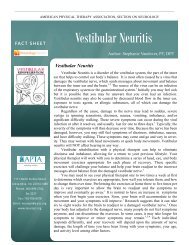Peripheral versus Central Vestibular Disorders - Neurology Section
Peripheral versus Central Vestibular Disorders - Neurology Section
Peripheral versus Central Vestibular Disorders - Neurology Section
- No tags were found...
Create successful ePaper yourself
Turn your PDF publications into a flip-book with our unique Google optimized e-Paper software.
AMERICAN PHYSICAL THERAPY ASSOCIATION, SECTION ON NEUROLOGYFACT SHEET<strong>Peripheral</strong> <strong>versus</strong> <strong>Central</strong> <strong>Vestibular</strong><strong>Disorders</strong>Author: Lisa Farrell, PT, PhD, ATC<strong>Peripheral</strong> <strong>Vestibular</strong> <strong>Disorders</strong> (PVD) include pathology of inner ear vestibularstructures as well as the vestibular portion of the eighth cranial nerve. 1 Suchpathology diminishes available sensory information regarding head position andmovement. These disorders include neuritis, labyrinthitis, bilateral vestibular loss,Meniere’s, BPPV, and vestibulopathy following surgical procedures (e.g.labyrinthectomy and acoustic neuroma).<strong>Central</strong> <strong>Vestibular</strong> <strong>Disorders</strong> (CVD) primarily involve the vestibular nuclearcomplex and the cerebellum, as well as structures of the reticular activating system,midbrain, and higher centers of cortical function. Pathology of the central vestibularstructures affects integration and processing of sensory input from the vestibular,visual, and somatosensory systems. The most common CVD include brainstemstrokes, head trauma, migraine-related vestibulopathy, multiple sclerosis, andcerebellar degeneration. 2Both PVD and CVD reduce the appropriate neural output for spatial orientation,postural control, and eye movement control. Individuals with either disorder mightreport problems of dizziness, imbalance, falls, and/or visual blurring (oscillopsia).1111 North Farifax StreetAlexandria, VA 22314-1488Phone: 800-999-2782,Ext 3237Fax: 703-706-8578Email: neuro@apta.orgwww.neuropt.org<strong>Vestibular</strong> Rehabilitation (VR) has been shown to be effective in reducingsymptoms and improving function for patients with vestibular disorders. 3,4,5,6 Thegoal of VR is to promote central nervous system compensation throughexercise-based strategies. 1,5 Three exercise approaches are used to reduceimpairments (dizziness, postural instability, and gaze instability) and promotereturn to function. Visual-vestibular interaction exercises, or adaptation exercises,encourage the adaptation of the remaining vestibular system to certain stimuli (i.e.,head movement). They are mainly used to treat persons with complaints of gazeinstability and have also been shown to reduce dizziness and improve balance. 7,8Substitution exercises are used to promote balance and reduce falls by using othersensory stimuli (e.g., visual or somatosensory input) to substitute for absent orreduced vestibular function. 9 Habituation exercises are used to reduce movement/position-induced dizziness through repeated exposure to noxious stimuli. Bysystematically producing mild, temporary symptoms, a reduction of dizziness canresult over time. 1,10
AMERICAN PHYSICAL THERAPY ASSOCIATION, SECTION ON NEUROLOGY<strong>Peripheral</strong> <strong>versus</strong> <strong>Central</strong><strong>Vestibular</strong> <strong>Disorders</strong>Differences in <strong>Vestibular</strong> Rehabilitation for PVD <strong>versus</strong> CVD Individuals withPVD primarily use adaptation exercise to improve gaze stability. Individuals withPVD or CVD can use both substitution and habituation exercise approaches toreduce imbalance and subjective complaints of dizziness. VR contributessignificantly to the successful treatment of PVD by returning the majority ofindividuals to normal function and a high quality of life. 6 Although peripheralimpairments may be permanent in individuals with PVD, they can achievecompensation faster because central vestibular function is intact. However, inindividuals with CVD, recovery from vestibular dysfunction is limited becausepathological involvement of central vestibular structures restricts compensation.Candidates most appropriate for VR are individuals with stable PVD and CVDpresenting with reports of gaze instability, imbalance, and/or dizziness. 3Individuals with PVD or CVD are typically seen by a physical therapist 1-2 timesper week for vestibular rehabilitation and are taught daily home exercises. Theexercises address their individual impairments and activity limitations. The averagelength of therapy for individuals with PVD ranges from 6 – 12 weeks. The length oftherapy for those with CVD is typically longer. 3,4References:1111 North Farifax StreetAlexandria, VA 22314-1488Phone: 800-999-2782,Ext 3237Fax: 703-706-8578Email: neuropt@apta.orgwww.neuropt.org1. Herdman SJ. <strong>Vestibular</strong> Rehabilitation. 3 rd ed. Philadelphia: F.A. Davis Company; 2007.2. Furman JM, Whitney SL. <strong>Central</strong> causes of dizziness. Physical Therapy. 2000; 80(2): 179-87.3. Shepard NT, Telian SA. Programmatic vestibular rehabilitation. Otolaryngol Head NeckSurg. 1995; 112:173-182.4. Whitney SL, Rossi MM. Efficacy of vestibular rehabilitation. Otolaryngol Clin North Am.2000; 33(3):659-672.5. Hillier SL, Holohan V. <strong>Vestibular</strong> rehabilitation for unilateral peripheral vestibular dysfunction.Cochrane Database of Systematic Reviews 2007, Issue 4. Art. No.: CD005397.DOI:10.1002/14651858.CD005397.pub2.6. Hall CD, Cox LC. The role of vestibular rehabilitation in the balance disorder patient. OtolaryngolClin North Am. 2009; 42:161-169.7. Horak FB, Jones-Rycewicz C, Black FO, Shumway-Cook A. Effects of vestibular rehabilitationon dizziness and imbalance. Otolaryngol Head Neck Surg. 1992; 106:175-180.8. Herdman SJ, Clendaniel RA, Mattox DE, Holliday MJ, Niparko JK. <strong>Vestibular</strong> adaptationexercises and recovery: acute stage after acoustic neuroma resection. Otolaryngol Head NeckSurg. 1995; 113:77-87.9. Herdman SJ. Recovery of dynamic visual acuity in bilateral vestibular hypofunction. ArchOtolaryngol Head Neck Surg. 2006;133:383-389.10. Smith-Wheelock M, Shepard NT, Telian SA. Physical therapy program for vestibular rehabilitation.Am J of Otology. 1991; 12(3): 218-225.11. Gill-Body KM, Popat RA, Parker SW, Krebs DE. Rehabilitation of balance in two patientswith cerebellar dysfunction. Physical Therapy. 1997;77:534-552.12. Herdman SJ. Treatment of vestibular disorders in traumatically brain-injured patients. J HeadTrauma Rehabil. 1990; 5(4):63-76.13. Whitney SL, Wrisley DM, Brown KE, Furman JM. Physical therapy for migraine-relatedvestibulopathy and vestibular dysfunction with history of migraine. Laryngoscope.2000;110:1528-1534.
















